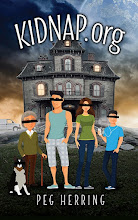Step Three to Writing a Book: Publishing
If you decide to self-publish, there are good prospects and bad ones. It's a complicated process, though it's much simpler now than it was a few years ago. It's hard to break it down, and the learning curve is brutal at times. While I've tried to develop a schedule that covers all the necessary steps, I find myself doing what I feel like doing on a given day and neglecting things I should be doing. That's bad, but since I don't consider writing a "job," I give myself a break and do what sounds doable at the time.
Here's what I work on in the months and weeks before publication.
Cover
Manuscript setup
Publicity
Corrections
Ordering
Let's start with the cover. The easiest thing to do is hire a cover artist, and ninety percent of experts will tell you to do that. I admit that I don't have the tools, smarts, or experience that a cover artist does, but here's the thing: they don't know the material like I do.
I had a really good cover artist for the first Maggie Pill book, THE SLEUTH SISTERS. She worked with me for a few years, and watching her, I learned a lot about how the process goes. Once she made the first book cover, she used that as a theme for the ones that followed. She was fast. She was reasonably priced. She listened to what I wanted.
Then, she left the business. I did the last few covers myself, using what I'd learned from her.
Artists work with what they're given and what they're told, and I think that overall, they do a great job. Still, I have several times received covers that made me go "What?" On my very first book cover, they used a picture of a castle that was 400 years out of date. On another, the girl looked like an android. Once, to continue a theme, they colored the woman's face green. She looked like she'd eaten bad sushi the day before.
Above is a cartoonish cover that I thought was cute when the artist sent it. I okayed it, but we found that it made people assume the book was YA. I went back to the artist to build a new cover to replace the "Scooby Doo" look. This is the one I like.
As for the others, I hated that robot-girl until I finally got the rights back and hired a new artist. And I eventually got rid of that gold-brick castle too.
All of this cost time and money, but I found that I like making my own covers. They're not as fancy as they should be, but I don't care. I learn a bit with each one, and I enjoy the process, so who am I hurting? I will say that if you want to actually make a living on your writing, hiring a cover artist is probably best. It isn't cheap, but like they say, it takes money to make money.
Pictures: If you're going to make your own covers, you will probably need to find a photo-sharing site, like AdobeStock or Photobucket. I type in what I'm thinking of for a cover pic and get hundreds of photos, some of which actually work for me. I download a few pictures (It's free, since they have their brand written across them until you pay) and play with them, to see which ones evoke the mood I'm looking for. Right now, I'm working on a story set in Michigan's UP, so I downloaded some woodsy pics and tried my lettering on them to see what I like. (So far, nothing.)
I hate that those sites make me pay a monthly fee when I really only need a few pictures a year, but some of them let me put my membership on hold, so I do.
Cover art establishes the genre and the mood, and hopefully creates the inclination to read a book. You'll find a great deal of variance in my covers, since my books are (though all in the mystery/suspense genre) very different from each other.
Here's one of my historical mysteries set in Tudor England:
Here's an oldie that I like because it's fun:
And here's a contemporary story of three sisters:
Lettering: For lettering that's not the usual Times New Roman or Arial, Google Fonts is a free site where you can download all sorts of interesting fonts. At first I got carried away there because it was fun, but my online critics soon let me know it isn't good to get too weird. (The letters dripping blood had to go.)
Publishing software: Of course, to create a cover, you need publishing software. That can get expensive, and I find a lot of it more complicated than I'm willing to work with. If I wanted something special, I'd hire it done. If I do it myself, I keep it simple and work in Publisher. Over time, I've learned tricks that help me change the look of a photo or blend elements together, eliminating the block-y or busy looks seen in some amateur covers.
Tricks: Some things you need to do at some point that will help prevent problems for you later.
* Blow the cover up really big and go over it inch by inch, inspecting every part of it to make sure edges line up, elements don't overlap, there aren't bits of forgotten text or pictures buried somewhere you can't see them, or other mistakes you've missed.
* Look for errors in punctuation/spelling at least a zillion times. (A cover artist once sent me a book with 'Someboady' on the spine. I didn't notice it for almost a year, because I only looked at the front and back.)
* Shrink the cover to thumbnail size and see if a person browsing a book-seller's site can tell what's on the cover and read the title and your name.
* Check the margins to make sure your text boxes are where they need to be. This is particularly important on the print cover, because it can look right to your eyeball when it isn't really centered on the back. More than once I've ordered advance copies and found they just didn't look right. (Which is one good reason we order advance copies!)
Cover submission: The most frustrating part of designing a cover for me is making a print cover that works for my two publishers, Amazon and Draft2Digital. They have different methods, different sizes, different responses to something that isn't working, and I sometimes spend days trying to figure out what the heck they don't like about what I submitted. Part of the reason is that each book's spine is different, depending on the number of pages. That means I can't just set up dimensions and go on; I have to work to make it fit. It requires a PDF file (which has its own quirks), so it's time-consuming to make the file, try it, and get rejected multiple times. This is where hiring of an artist is most valuable to me, because they know what they're doing and I don't, but I've learned to embrace the headaches and keep trying until the cover is accepted.
Versions: When I build a cover, I need at least five versions: print for Amazon, print for D2D, e-book in a regular file size (for sharing on FB or other social sites), e-book in a big file size (for advertisers, etc.), and audio. Each of those should be saved on a hard drive or in the cloud, clearly marked, so you can find it when you need it. Changing anything might mean you have to change all the versions, so it's best to make sure the original is right before you go on to create the others.
Timing: I like to make the e-book cover early on, because I use it to stir interest. The good thing is that it can change if I see a need. I decided with my newest Maggie Pill to add "Author of the Sleuth Sisters Mysteries," since that's kind of what Maggie is known for. With just that first file, I can easily add something or make it better in some way. Other covers come as I need them, with audio usually being last.
Testing: My first tester for covers is my husband. He has no interest in the type of books I write, so he reacts purely on a gut level: Does the cover grab a person's attention? Is its purpose clear? Is there something that distracts because it's odd or out of place?
Next I test my covers here and on Facebook, my go-to social media site. Readers are great about chiming in to praise or offer suggestions, and I appreciate that, acknowledging that I have very little in the way of raw artistic talent. It can be frustrating when half say they love Cover A and half vote for Cover B, but even that says to me that there isn't enough difference between the two to fuss about.
Of course, the acid test of a cover is the buying public. Authors would love a way to find out if a cover influences purchase, but as far as I know, Amazon hasn't yet come up with an algorithm for that.









Comments
Post a Comment